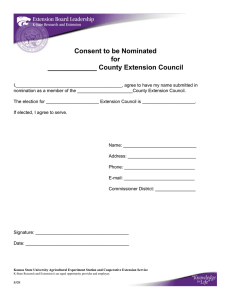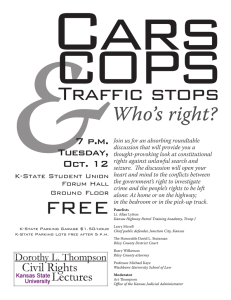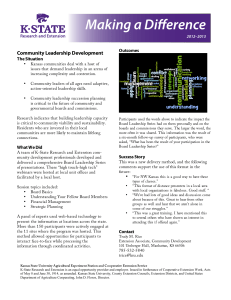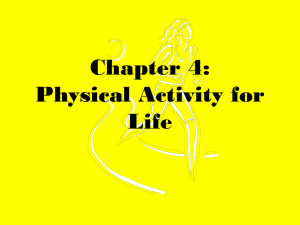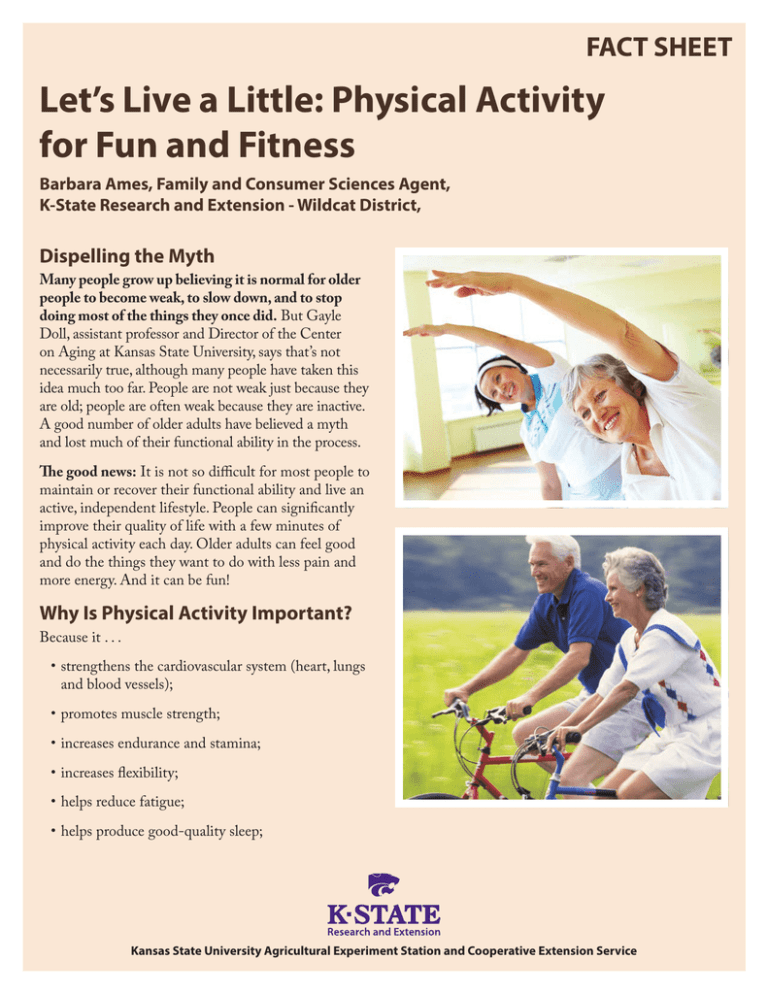
FACT SHEET
Let’s Live a Little: Physical Activity
for Fun and Fitness
Barbara Ames, Family and Consumer Sciences Agent,
K-State Research and Extension - Wildcat District,
Dispelling the Myth
Many people grow up believing it is normal for older
people to become weak, to slow down, and to stop
doing most of the things they once did. But Gayle
Doll, assistant professor and Director of the Center
on Aging at Kansas State University, says that’s not
necessarily true, although many people have taken this
idea much too far. People are not weak just because they
are old; people are often weak because they are inactive.
A good number of older adults have believed a myth
and lost much of their functional ability in the process.
The good news: It is not so difficult for most people to
maintain or recover their functional ability and live an
active, independent lifestyle. People can significantly
improve their quality of life with a few minutes of
physical activity each day. Older adults can feel good
and do the things they want to do with less pain and
more energy. And it can be fun!
Why Is Physical Activity Important?
Because it . . .
•strengthens the cardiovascular system (heart, lungs
and blood vessels);
•promotes muscle strength;
•increases endurance and stamina;
•increases flexibility;
•helps reduce fatigue;
•helps produce good-quality sleep;
Kansas State University Agricultural Experiment Station and Cooperative Extension Service
•helps balance and coordination;
Where Do I Begin?
•reduces anxiety and depression;
Research shows it doesn’t take hours of painful,
sweat-soaked exercise to achieve most of the health
benefits of physical activity. Short periods of gentle
physical activity can significantly improve health and
fitness, reduce disease risks, and boost your mood.
Even a few minutes a day can work wonders.
•helps regain physical function;
•helps prevent constipation;
•improves ability to participate in family and social
activities;
•helps prevent bone loss, resulting in fewer fractures;
•increases life expectancy; and
•helps reduce weight or helps maintain a healthy
weight (reduces stress on joints).
Regular physical activity is one of the most important
things you can do for your health, no matter your
age, according to the Centers for Disease Control
and Prevention. As you age, muscle strength declines.
You can lose up to one-half of your strength and
muscle mass between the ages of 25 and 80 if you
don’t do something to prevent the loss. Regular
physical activity not only prevents muscle loss, it
also can increase muscle strength and muscle mass;
increase bone density; and reduce the risk for chronic
diseases such as diabetes, heart disease, osteoporosis,
and arthritis. Physical activity helps your muscles
grow stronger so you can keep doing your day-to-day
activities without becoming dependent on others.
Long periods of inactivity can lead to weakness,
stiffness, fatigue, and a variety of ailments, for
anyone. Although there are no cures for many of
the illnesses in the world, the cure for inactivity is
known — exercise!
A complete program of physical activity should
include three types of activities.
Flexibility activities stretch or loosen muscles and
joints and help with balance and coordination. Do
these slowly, holding each stretch for a few seconds.
Stretch major muscle groups three or more times
per week. Don’t bounce; stretch slowly until you feel
comfortable tension, not pain. Hold the stretch for
10 to 30 seconds and breathe freely throughout the
stretch. (Do not hold your breath.)
Strengthening activities make your muscles stronger
by working them harder and are usually done against
resistance. They also help balance and coordination.
Recommendations include 8 to 10 strengthening
exercises two to three days a week. It’s best not to do
strengthening exercises every day — a day between
gives muscles and joints time to adapt and strengthen.
Strength training has proven beneficial in older adults
— even those in their 90s.
Endurance or aerobic activities are also called
cardiovascular exercises. They work most of the body
and include walking, biking, dancing, and swimming.
Moderate aerobic activities for 20 to 30 minutes, three
to five days a week are recommended. To be most
effective, these activities should be done for a total of
150 minutes per week. When exercising at a moderate
level, you should be able to talk comfortably while
doing the activity.
If you have not been exercising before, it is best
to consult with your physician before beginning,
especially if you have a chronic disease. But for most
people, it is more dangerous to be physically inactive
than it is to begin an exercise program.
Listen to your body and keep track of how you are
feeling to know if you’ve done too much. If you get
out of breath or are so tired that you have to stop
before completing 10 minutes of an activity, then you
are working too hard. Next time slow down, do less, or
work at a less intense level.
Almost everyone can gain the health benefits of
physical activity — age, ethnicity, shape, or size do
not matter. Even if you are unable to walk, there are
activities you can do to benefit your health right in
your own chair.
When planning your program, start where you are
now and gradually increase your activity toward the
ultimate goals suggested.
Planning Your Physical Activity Program
•The best way to enjoy and stick with your exercise
program is to suit yourself. Choose what you
like to do, find a place where you feel comfortable,
and select an exercise time that fits your schedule.
Exercising with music may also add to your
enjoyment.
•Pick two or three activities you think you would
enjoy and that wouldn’t put undue stress on your
body. Change your activities occasionally so you
don’t get in a rut. See the chart on the next page
for some ideas.
•Having fun is a benefit of exercise that often
goes unmentioned. Learn to think of exercise as
recreation rather than a chore.
•Make an exercise diary or calendar to help track
your progress (walking farther, feeling better,
sleeping better, more energy, etc.).
•Set specific goals. Not “I want to walk more,” but
“I plan to walk for 30 minutes after breakfast every
other day.”
•Reward yourself for even small successes. If
you miss a day, don’t stress. Just vow to try again
tomorrow.
•Include warm-ups. If you are going to exercise at
an intensity that causes you to breathe harder or
your heart to beat faster, it is important to warm
up first. A warm-up means that you do at least 5
minutes of a low-intensity activity to allow your
heart, lungs, and circulation to gradually increase
their work. If you are going for a brisk walk, warm
up with 5 minutes of slow walking first. Warming
up reduces the risk of injuries, soreness, and
irregular heartbeat.
•Cool-downs are just as important. A cool-down
period is important if you have exercised at an
intensity that required you to breathe harder,
your heart to beat faster, you felt warmer, or you
perspired.
Repeating the 5-minute warm-up activity or
taking a slow walk helps your muscles to gradually
relax and your heart and breathing to slow down.
Gentle stretching and flexibility exercises during
the cool-down can be effective for increasing
motion because your muscles and joints are warm
and more easily stretched. Stretching gently now
also helps reduce the muscle soreness and stiffness
that may follow vigorous exercise.
A Healthy Choice
When it comes to your personal fitness program,
making a plan, sticking with it, and doing it your way
makes you a definite winner! Remember, advancing age
is no excuse. You can improve your functional ability
and your health.
Choose to put physical activity into your day — every
day — for fun and fitness!
What Physical Activities Should I Do?
For best health, participate in activities from each of these three groups.
Flexibility (Range of Motion)
Resistance/Endurance (Muscle Strength)
Cardiovascular (Healthy Heart)
Moves joints through their full range
of motion.
Works the muscles against a force.
Increases the heart rate for a longer
period of time.
Advantages:
Advantages:
Advantages:
• Increases ease of movement
• Makes muscles stronger
• Improves heart health
• Improves ability of the elderly to
maintain independence
• Tones the body
• Burns calories for weight loss or
maintenance
• Reduces risk of chronic disease
Examples:
• Stretching after doing exercise
• Classes such as yoga, pilates,
martial arts, or tai chi
Examples:
Examples:
• Lifting homemade weights (milk jugs filled
with water, canned foods)
• Walking
• Using exercise bands or tubes
• Bicycling (either stationary or
outdoor)
• Using a medicine ball to build core strength
• Using body weight (push-ups, chair sits,
stomach curls)
• Lifting free weights (dumbbells)
• Using weight machines (most often found in a
fitness center or gym)
• Group exercise classes or videos (muscle
conditioning)
Daily, or at least three days per week
Twice per week, skipping one day between
workouts
Information Sources
Living a Healthy Life with Chronic Conditions, (Fourth
Edition), 2012. Kate Lorig, Halstead Holman, David Sobel,
Diana Laurent, Virginia Gonzalez, and Marian Minor. Bull
Publishing Company.
It’s a Great Life! 1997. Gayle Doll, Director of the Center
on Aging, Kansas State University. (Five-part exercise series
on two DVDs. Center on Aging catalog number M600.37;
call 785-532-5945 to order.)
Activity for the Ages! 2005. Mike Bradshaw, Ph.D., Elizabeth
W. Fox, Stacy Toner, Kansas State University Extension;
Paul Estabrooks, Ph.D., Kaiser Permanente of Colorado.
MF2670, http://www.ksre.ksu.edu/bookstore/pubs/MF2670.pdf
What Can Physical Activity Do for Me? 2008. Lori Rice,
MS, CN and Jackie Walters, MBA, RD, LD, University of
Kentucky Extension. NEP-212e, http://www.ca.uky.edu/agc/
pubs/nep/nep212e/nep212e.pdf
Publications from Kansas State University are available at: www.ksre.ksu.edu
Publications are reviewed or revised annually by appropriate faculty to reflect
current research and practice. Date shown is that of publication or last revision.
Contents of this publication may be freely reproduced for educational purposes.
All other rights reserved. In each case, credit Barbara Ames, Let’s Live a Little:
Physical Activity for Fun and Fitness, Fact Sheet Kansas State University, July 2013.
• Running
• Dancing
• Group exercise (chair aerobics,
low impact aerobics)
• Climbing stairs
• Vigorous yard work (lawn
mowing, raking)
30 minutes on five or more days per
week
Increasing Physical Activity as We Age: Strength Training With
Medicine Balls, 2012. Jessica Vincent, LaVona Traywick,
Ph.D., Lisa Washburn, Dr. PH; University of Arkansas,
www.uaex.edu/Other_Areas/publications/pdf/FSFCS37.pdf
Information from the Centers for Disease Control and
Prevention website:
www.cdc.gov/physicalactivity/everyone/health/index.html
www.cdc.gov/physicalactivity/everyone/guidelines/olderadults.
html
Author
Barbara Ames, Family and Consumer Sciences Agent
K-State Research and Extension - Wildcat District
Reviewers
Sharolyn Jackson, Family and Consumer Sciences
Specialist, K-State Research and Extension-Northeast Area
Tanda Kidd, Ph.D., Human Nutrition Specialist, K-State
Research and Extension
Kansas State University Agricultural Experiment Station and Cooperative
Extension Service
K-State Research and Extension is an equal opportunity provider and employer.
Issued in furtherance of Cooperative Extension Work, Acts of May 8 and June
30, 1914, as amended. Kansas State University, County Extension Councils,
Extension Districts, and United States Department of Agriculture Cooperating,
John D. Floros, Director.
MF3090
July 2013


